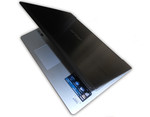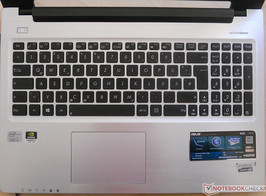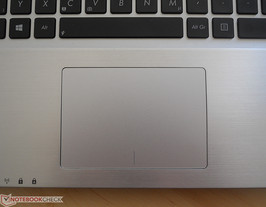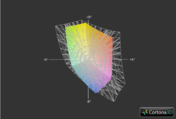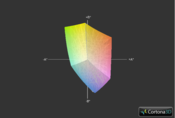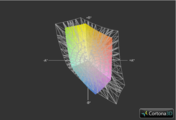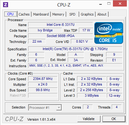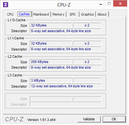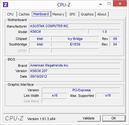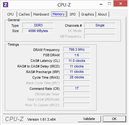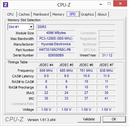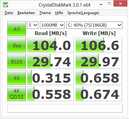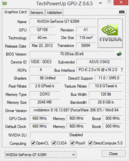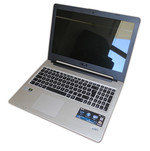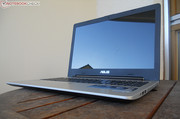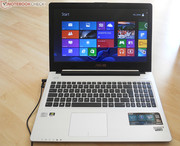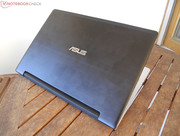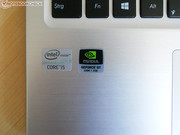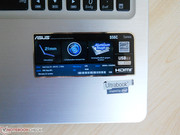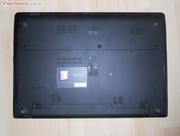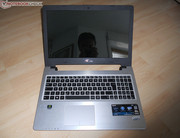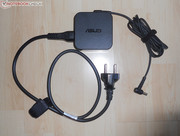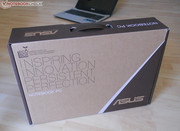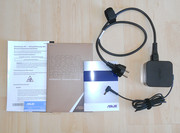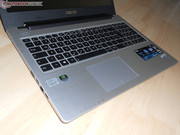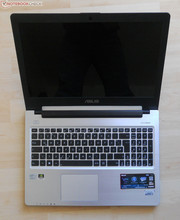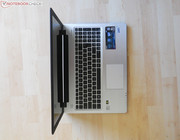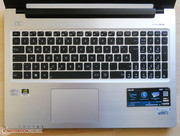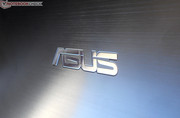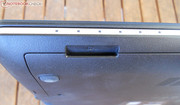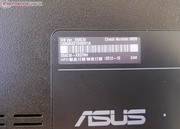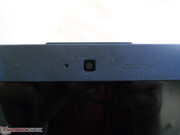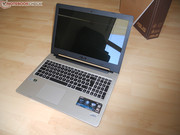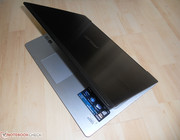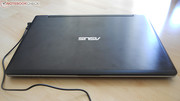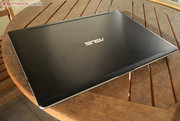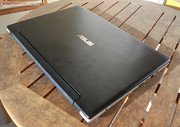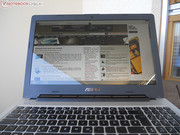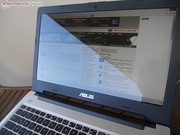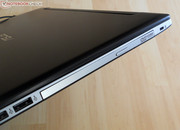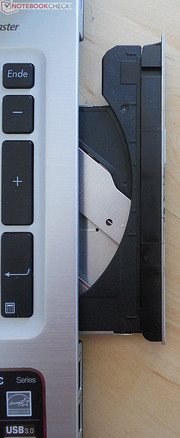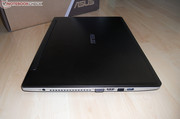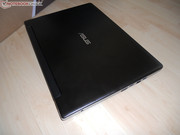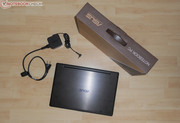Review Asus S56CM Ultrabook

Asus and ultrabooks - the first thing that pops to mind is the Zenbook range and models such as the UX31A or UX32VD.
Now, in addition to the premium market, Asus wants to join the mainstream market with the S56CM. Also listed as K56CM it debuted at the IFA 2012 and enters the race with a 21 mm (0.83 inches) slim ultrabook with a 15.6-inch display for 700 Euros (~$890).
The chances are not bad at all when looking at the spec sheet and the laptop's technical equipment. An energy-efficient yet strong Intel Core i5-3317U processor, a powerful Nvidia GeForce GT 635M and an exchangeable battery in a slim aluminum chassis that also sports an optical drive will likely be worth considering for a number of potential buyers.
How the big ultrabook fares in our extensive Notebookcheck test course will be illustrated in this review.
Case
"Aluminum Tough" - Asus refers to the aluminum applications on the S56CM's casing with this marketing term. Unlike the Zenbooks, a full-aluminum casing or even a unibody build (UX31A) is not used here. Instead single parts of the casing consist of the elegant metal.
The black display lid that suggests a high robustness and quality with its pleasant and cool feel the first time we touch it is also among these parts. The base unit is also clad in elegant brushed aluminum, but in a stylish silver rather than black. All this quickly creates a positive and surprisingly high-end first impression.
The casing of Asus' S56CM cannot completely confirm the preliminary impression at second glance. The build quality is absolutely satisfactory for a consumer device from this price range. However, just opening the ultrabook seems a bit too easy and consequently the lid opens by half a centimeter when the device is placed on its rear because the lid does not close securely enough to the base unit. Thus, the user should take care particularly when carrying the ultrabook around because the sensitive screen is not protected by a tighter closure.
Beyond that, the display hinges keep the lid firmly enough in position, but it nevertheless rocks visibly on even slightly vibrating surfaces. We would appreciate considerably tighter hinges with a firmer hold here.
In terms of torsional stiffness, neither the display lid nor the base unit yields to warping, not even under selective pressure. The casing can only be dented marginally when stronger pressure is applied by a finger on the right, above the built-in DVD burner and on the keyboard. The keyboard flexing, which is a known problem especially from Asus' UX32VD, hardly exists in this model and does not deter a normal use of the keyboard in any way.
The mentioned DVD drive is a positive unique selling point in a slim ultrabook, but the very fragile and wobbly implementation is disagreeable. The user should handle it very carefully in order to prevent damage. The drive also has too much play which causes unsightly scratches on the drive's upper edge.
Overall, the Asus S56CM can be said to have a more than satisfactory casing quality. However, the potential buyer should keep in mind that the ultrabook does not go beyond the standard quality of a low-budget consumer device despite the aluminum components.
Connectivity
Asus' consumer ultrabook can compete with the contenders in terms of connectivity and copes very well with this category.
The S56CM reaps in plus points especially with its DVD burner in contrast to most ultrabooks, where the optical drive is omitted. Only few contenders can provide that, e.g. Acer's Aspire TimelineUltra M5.
The other available interfaces also provide the user with the most important ports: 3x USB (2x USB 2.0, 1x USB 3.0), a LAN RJ45, the mandatory headphone/microphone jack, a card reader and HDMI and VGA (full-size) for multi-monitor use.
However, the interface distribution is a bit cramped. For example, interfaces are clustered particularly on the casing's left front and could cause a cable mess. Also the fan on the left might prove to be quite uncomfortable for left-handed users.
The rear does not have any ports due to the display's mounting and the battery located between the hinges. The front merely accommodates the built-in card reader.
Communication
Besides connectivity, Asus' new S56CM also presents a good array of communication options. In addition to the standard Ethernet RJ45 port for cabled network access, a Wi-Fi adapter for wireless connections is naturally among these. An integrated Bluetooth interface for wireless file transfer finishes off the S56CM's communication equipment.
Accessories
The scope of accessories for Asus' S56CM corresponds to the industry standards. Asus' S56CM includes a 45 Watt PSU, a quick start guide and a few information leaflets from the manufacturer in addition to the ultrabook itself and a preinstalled version of the latest Windows 8.
We miss a recovery DVD just as much as a partition on the hard disk for resetting the operating system easily and quickly to its default state.
Warranty
Asus includes a 24-month warranty on its new mainstream ultrabook free of charge. Although this is standard in this price range, a warranty period of merely 1 year has also established itself among a few manufacturers.
Input Devices
Keyboard
The S56CM's chiclet keyboard corresponds to the standards and broad average for a multimedia laptop of this price range. The keyboard pleases with a soft stroke, which allows low-noise typing and completely prevents the keyboard from clattering. On the other hand, it is just this soft stroke that prevents a crisp and clearly defined feedback. Many prolific typists might find this as somewhat spongy as well as uncomfortable due to the rather short key drop.
In return, the built-in number pad that has found room in the key field is a plus point. It does not make a cramped impression, but rather provides the user with a clearly arranged and complete keyboard.
The chiclet keyboard's quality impression is not as pleasing. The keys' slightly roughened surface provides a pleasant feel and grip, but the keyboard makes a rather cheap impression and the keys seem fairly thin. However, the keyboard's quality is absolutely acceptable for an ultrabook with a price of just under 700 Euros (~$890).
Finally, we miss the UX32VD's backlit keyboard a bit. But the competition does not supply this in this price range either.
Touchpad
The touchpad known from the Zenbooks is a lot like the inputs from Apple's MacBook Pro models both in terms of feel and looks. The design without dedicated mouse keys, introduced by American manufacturers, is now used by many companies and in many models. Asus' S56CM also features this design. The generous size of 7.5 x 10.5 cm (~3 x 4.1 inches) enables comfortable use and users will unlikely want to change back to smaller touchpads. The sleek surface also provides a pleasant feel and very good gliding traits. However, the driver calibration and the detection of various multi-touch gestures did not always work perfectly on our early test sample. For example, the 2-finger scroll gesture was sometimes not recognized and impaired the touchpad's otherwise very good handling.
The touchpad's slightly lopsided installation mars the overall good impression of our test model. However, single cases are known from the premium UX32VD model.
Display
The first thing that strikes us when comparing the 15.6-inch screen to the premium range Zenbook models is the glossy screen surface. Unlike the matte screen found in the Zenbook range, the buyer has to be satisfied with the reflective glossy-type version in Asus' S56CM consumer ultrabook.
Although this is the standard in this price range and is also used by the competition, the reflective surface proves to be a drawback compared with matte versions, particularly outdoors in brighter surroundings.
The other specs of the installed screen unfortunately do not go beyond the usual standard of low-budget multimedia laptops. As expected, a TN screen is installed in Asus' S56CM, which features the equally common resolution of 1366x768 pixels. This naturally results in a limited high-resolution picture and a fairly small virtual desktop space on a 15.6-inch display.
| |||||||||||||||||||||||||
Brightness Distribution: 86 %
Center on Battery: 166 cd/m²
Contrast: 626:1 (Black: 0.35 cd/m²)
44.27% AdobeRGB 1998 (Argyll 3D)
63.7% sRGB (Argyll 3D)
42.76% Display P3 (Argyll 3D)
In return, the screen in our test device scores well in terms of image contrast and black value. The measured, high contrast of 622:1 adds up to a low black value of 0.35 cd/m2, which results in a particularly good and relatively saturated black reproduction. This results in a decent picture quality on the ultrabook's screen.
The S56CM's display naturally cannot cover the large sRGB color space in our subsequent measurement, but that is normal for a mainstream screen. It looks the same for the equally middling screen in Acer's Aspire TimelineUltra M5, which is even slightly inferior to Asus' screen. As expected, Asus' S56CM is clearly defeated by the first-rate screen in the premium UX32VD model in a direct comparison.
As mentioned earlier, the S56CM's reflective screen partly upsets any plans of outdoor use. Annoying, strong reflections complicate reading the displayed content, even in full screen brightness.
This brings us to the next point. The screen's brightness is also decisive for rendering. However, the S56CM's brightness of 203.2 cd/m2 is not only too low for compensating the intense reflections outdoors, but also quickly finds its limits in bright surroundings and light-flooded rooms. The user will sometimes be faced with disturbing reflections, especially on a dark screen.
Finally, we will take a look at the viewing angles in our Display test category. As would be assumed from an average TN screen, this category is definitely not one of the strengths of Asus' S56CM mainstream ultrabook.
The vertical direction especially shows intense color deviations such that any changing from optimal vertical angles quickly reduces the colors. This phenomenon is not as severe on the horizontal plane, but the picture quality suffers very visibly. This may be preventable and thus bearable when only one person uses the computer, but DVD nights will likely get unsatisfactory very quickly for any additional viewers.
Basically, the screen is not the specialty of Asus' S56CM. The screen's rather average maximum brightness, the very moderate viewing angles and above all, the glossy-type surface, prevent a good rating in this category. The good contrast and black value cannot completely compensate for that either.
Performance
The ultrabook scores again in our next test category - Performance. A look in the spec sheet gives hope for appealing computing power in view of Intel's energy-saving yet potent Core i5-3317U and, above all, Nvidia's GeForce GT 635M.
By installing Nvidia's dedicated GPU, Asus' ultrabook definitely supplies an attractive as well as a strong purchase argument. Ultrabooks are usually too weak for more computing-intensive tasks due to Intel's HD 4000 or HD 3000 processor graphics. Asus also installs a hybrid hard disk with a plentiful 500 GB of storage and a 24 GB SSD cache from Sandisk for good system performance. Asus does not make any giant leaps in terms of working memory and builds a 4 GB DDR3 RAM into the consumer ultrabook, which is absolutely sufficient for most current application scenarios.
Processor
As the "U" already indicates, the installed Intel Core i5-3317U processor belongs to the energy-efficient ULV (ultra-low voltage) CPUs from the American chip manufacturer, which also is one of the specifications for the trademarked term "ultrabook". These CPUs enable a long battery runtime due to a maximum dissipation of 17 TDP. However, they also compute a bit slower than the standard voltage models.
Asus' S56CM is available in three different CPU configurations. Besides the i5-3317U from the latest Ivy Bridge generation in our test device, the manufacturer also has the smaller i3-3217U and the top model i7-3517U to choose from.
We tested the factual performance of the dual-core ULV CPU using the reference benchmarks Cinebench R10 and R11.5 in different settings. Owing to Turbo Boost, Intel's up to 2.6 GHz fast Core i5-3317U in Asus' S56CM provides average scores. Although they are impressive for a ULV CPU, they lag behind a comparable standard voltage model.
| Cinebench R10 | |
| Rendering Single CPUs 64Bit (sort by value) | |
| Asus S56CM-XX079H | |
| Asus N55SL-S1016V | |
| Wortmann Terra 1450 II | |
| Acer Aspire TimelineUltra M5-481TG-73514G25Mass | |
| Toshiba Satellite L850-153 | |
| Rendering Multiple CPUs 64Bit (sort by value) | |
| Asus S56CM-XX079H | |
| Asus N55SL-S1016V | |
| Wortmann Terra 1450 II | |
| Acer Aspire TimelineUltra M5-481TG-73514G25Mass | |
| Toshiba Satellite L850-153 | |
System Performance
After the CPU rendering benchmarks, we are now interested in the S56CM's more comprehensive, overall system performance, so not only the single components, but also the system's entire performance in various tasks.
Our test device was faced with the usual PCMark 7 and PCMark Vantage programs. However, the latter did not detect the GPU in Asus' S56CM even after several attempts and thus did not provide a score for the system performance. PCMark 7 did not record top system performance rates for Asus' ultrabook. The bottleneck is found in the i5 ULV CPU, which cannot compete with stronger standard voltage processors as well as the now somewhat obsolete 5400 rpm HDD from Hitachi that would naturally be clearly defeated by a swift SSD. The advantage of a "genuine" SSD is seen here, which would influence PCMark 7 positively in contrast to the much cheaper hybrid alternative.
| PCMark 7 Score | 2532 points | |
Help | ||
Storage Devices
As mentioned, a now somewhat older 5400 rpm HDD spins in the Taiwanese computer giant's mainstream ultrabook. However, a 24 GB SSD cache from Sandisk, implemented as a hybrid solution, is meant to speed things up. Hybrid storage devices are increasingly being used in low-budget laptops and especially in ultrabooks. They are a low-cost alternative to the still quite expensive SSDs and combine their speed with the large storage capacity of conventional hard disks.
Owing to the SSD cache, the system is quite fast in performing tasks, such as system boot or waking from standby as specified in Intel's ultrabook guidelines. The S56C boots within 20 seconds and the so-called "Instant On" from standby is even ready after 5 seconds. The read and write speeds of a conventional hard disk, which we ascertain using HDTune and CrystalDiskMark, are of course not nearly as fast as in a system that completely relies on an SSD storage device.
Graphics Card
The graphics performance is likely one of the more interesting categories of Asus' S56CM. A dedicated graphics card in an ultrabook is still rare and will surely attract the attention of performance-oriented ultrabook target groups.
One of the few contenders is the Zenbook UX32VD from Asus, which sports the same CPU and a GT 620M, which calculates approximately 50% faster than the integrated Intel HD 4000. It belongs to the midrange dedicated GPUs. Asus builds a faster model into its new S56CM with Nvidia's GeForce GT 635M. It spares the battery via Optimus and can compete with other strong ultrabooks, such as Acer's Aspire TimelineUltra M5 (Nvidia GT 640M). Thus, the ultrabook should also be interesting for casual gamers.
As usual, we check the GT 635M's performance in the S56CM using reference benchmarks, such as 3DMark 06, the newer 3D Mark 11 and 3CMark Vantage as well as Unigine Heaven 2.1. The relatively low 3DMark 06 score of 8302 points however shows that the i5-3317U processor is again a bottleneck particularly in this graphics and processor-heavy benchmark and pushes the performance roughly 20% below the usual average of ~10400 points. The more graphics-heavy 3DMark 11 does a better job in revealing the GT 635M's performance and records 1126 points.
| 3DMark 06 Standard Score | 8302 points | |
| 3DMark Vantage P Result | 5013 points | |
| 3DMark 11 Performance | 1126 points | |
Help | ||
Gaming Performance
Ultrabook and gaming? Yes, it's possible.
Of course, you should keep in mind that slim ultrabooks are not full-blown and powerful gaming machines, and Asus' 21 mm thin S56CM is no exception. Nevertheless, we can record a good gaming performance with our test device. It currently belongs to the strongest members of the ultrabook category created by Intel. Unfortunately, the low-voltage CPU specified in the ultrabook guidelines slows the potential of Nvidia's GT 635M by approximately 20% in contrast to a comparable standard voltage processor. This will likely be noticed particularly in somewhat CPU-heavier games, such as Anno 2070. However, the premium UX32VD featuring a GT 620M cannot really put the S56CM in its place. Despite the same CPU and a marginally slower graphics card, the Zenbook shows a slightly better performance in, for example, Anno 2070.
A quite big difference of over 30% is also seen in the comparison with the processor-sparing game Skyrim on Asus' N55SL, which features the same GPU but a standard voltage i5-2450M. Basically, the gaming performance of Asus' S56CM is absolutely decent for an ultrabook and is sufficient for most up-to-date games in the native resolution of 1366 x 768 and medium details.
| The Elder Scrolls V: Skyrim | |
| 1920x1080 Ultra Preset AA:8x AF:16x (sort by value) | |
| Asus S56CM-XX079H | |
| Asus N55SL-S1016V | |
| 1366x768 High Preset AA:8x AF:8x (sort by value) | |
| Asus S56CM-XX079H | |
| Asus N55SL-S1016V | |
| 1366x768 Medium Preset AA:4x (sort by value) | |
| Asus S56CM-XX079H | |
| Asus N55SL-S1016V | |
| 1280x720 Low Preset (sort by value) | |
| Asus S56CM-XX079H | |
| Asus N55SL-S1016V | |
| low | med. | high | ultra | |
|---|---|---|---|---|
| Crysis 2 (2011) | 60.4 | 40.96 | 30.18 | 10.44 |
| The Elder Scrolls V: Skyrim (2011) | 45.81 | 32.65 | 23.79 | 12.83 |
| Anno 2070 (2011) | 79.8 | 31.01 | 20.01 | 9.69 |
Emissions
System Noise
An ultrabook should be an ultra-slim, portable and light laptop with low emission rates.
Noise is harder to mask when high performance meets a slim casing, which must blow the higher accumulated waste heat quietly out of the device. Our test device manages this quite well.
The fan runs permanently even in idle, i.e. only easy office/Internet load. However, Asus' S56CM accomplishes this so quietly that it is only audible when an ear is placed on the base unit and then it is even drowned out by the HDD's quiet hum. Thus, the idle noise development is virtually inaudible.
This is logically different during load (stress test), where the fan naturally spins more audibly than in idle in order to discharge the produced waste heat out of the casing. The noise level settles to an acceptable 41.4 dB(A) in this high-load scenario. The laptop’s noise is of course very audible subjectively during high system load. Nevertheless, it is not perceived as annoying, especially since such a load will hardly if ever be demanded of the system in routine use.
Noise level
| Idle |
| 30.5 / 30.7 / 30.7 dB(A) |
| HDD |
| 32.6 dB(A) |
| DVD |
| 36.3 / dB(A) |
| Load |
| 41.4 / 44.8 dB(A) |
 | ||
30 dB silent 40 dB(A) audible 50 dB(A) loud |
||
min: | ||
Temperature
The rating of Asus' S56CM operating temperatures looks similar. The casing remains within a very pleasant temperature range of the mid-20s °C (~75-79 °F) during low load. Of course, (full) load performance takes its toll on the temperatures and the hardware components produce a much higher waste heat. They are within a moderate range of 83-86 °C (~181-187 °F) for the CPU and a maximum of 84 °C (~183 °F) for the GPU, which can be called absolutely harmless. For comparison, a hardware temperature of clearly above 90 °C (~194 °F) is not uncommon for some devices during full load. We also fortunately did not observe CPU or GPU throttling in the stress test for this reason.
The casing of our test device also warmed up noticeably, but still remained fairly cool during this high computing load. Owing to the base unit's aluminum surface it is still perceived as a pleasant temperature. It is not recommended to use the device on the lap in high-load operations, e.g. a gaming session, because of the laptop's higher temperature development at the bottom. In return, this is not a problem in office use.
Finally, we can confirm that the S56CM has a good cooling system that keeps both the internal and external heat emissions within a low and thus very good limit.
(±) The maximum temperature on the upper side is 44 °C / 111 F, compared to the average of 36.9 °C / 98 F, ranging from 21.1 to 71 °C for the class Multimedia.
(-) The bottom heats up to a maximum of 51 °C / 124 F, compared to the average of 39.2 °C / 103 F
(+) In idle usage, the average temperature for the upper side is 29.1 °C / 84 F, compared to the device average of 31.3 °C / 88 F.
(±) The palmrests and touchpad can get very hot to the touch with a maximum of 38.5 °C / 101.3 F.
(-) The average temperature of the palmrest area of similar devices was 28.7 °C / 83.7 F (-9.8 °C / -17.6 F).
Speakers
No matter whether videos, music, computer games or Skype - the built-in speakers are involved in many tasks and are therefore not an insignificant component in a multimedia laptop. Upon testing the speakers of the S56CM we found nothing to get excited about. Naturally, a high-quality sound system cannot be expected in a laptop, but we would have hoped for something a bit better from the multimedia laptop. The somewhat tinny and rather thin sound alongside the almost nonexistent bass are no fun on the S56CM. Music sounds extremely thin and meek, although the volume exhibits an impressive maximum. However, that is not exactly beneficial for the sound quality.
That is too bad because fairly decent speakers should belong to the standard equipment, especially for a multimedia laptop like the S56CM. However, the competition in this price range does not offer better alternatives.
Battery Life
Power Consumption
Our test device's power consumption is within the range of comparable ultrabooks, such as the TimelineUltra M5. The average power consumption of 9.1 Watts in the low-load idle range is pleasantly low and is especially owed to the ULV CPU and the energy-efficient Intel graphics selected via Optimus. Even during load, where the S56CM's power requirement naturally increases, we ascertained good energy efficiency with a maximum of 60.1 Watts, particularly since this rate was achieved in the unrealistic stress test (FurMark+Prime95).
| Off / Standby | |
| Idle | |
| Load |
|
Key:
min: | |
Battery Runtime
[Update: 2012/11/06] A renewed measurement with a manually disabled Nvidia GPU did not improve the unusually short battery life in load. However, we assume that a faulty battery was in our test device because the battery's capacity alongside the low power consumption should have resulted in a much better result.
A good battery runtime is another important criterion for an ultrabook because this allows the high portability of this laptop category. Regrettably, Asus' S56CM does not reap in very many plus points here. The 44 Wh lithium-ion battery in our test device greatly surprised us with a very poor time of just below 3.5 h in the test of the maximum possible battery runtime (min. brightness, wireless off, word processing only) and brought no improvement even after a total of three measurements. We cannot exclude a soft- or hardware problem, but the ascertained runtime does not give much hope for the other three tests with higher computational requirements. The consumer ultrabook's battery was drained after only 1h 13min in the test of the minimum possible runtime using load and maximum screen brightness as well as enabled wireless modules. The more practical Wi-Fi test, which finished after a mediocre 2.5 h and the DVD rendering test (2h 16min), provide a more realistic view of the ultrabook’s possible runtime away from the mains. Sobering, just sufficient, results for the S56CM's potential in this category.
The only remedy for this would be a spare battery. It is at least possible to exchange the S56CM's battery in contrast to most competing models featuring a built-in battery.
Verdict
With the S56CM aka K56CM, Asus tries to advance into the still fairly sparse consumer and mainstream ultrabook market.
However, the Taiwanese manufacturer is only partly successful with its just under 700 Euros (~$890) S56CM. Of course, the price is a strong argument for a slim, 15.6-inch ultrabook featuring a dedicated graphics card like our test laptop. On the other hand, it is this price that is noticed in our review of the S56CM.
The sufficient but not really satisfactory product quality, no genuine SSD, the reflective and color-weak TN screen alongside its poor viewing angles and especially the baffling as well as surprisingly poor battery life add weight to the con side. Especially the last two points contradict the actual purpose of an ultrabook and restrict the S56CM's outdoor suitability. Consequently, Asus' S56CM can only be rated as "merely" an ultra-slim multimedia laptop with good performance that reaps in plus points with its stylish design, aluminum applications, good cooling system without throttling and the aforementioned low price and thus will certainly find its fans.
Potential buyers who expect a bit more power can opt for Asus' S56CM with a slightly stronger i7-3517U CPU or take a look at Acer's 15.6-inch Aspire TimelineUltra M5 featuring a GT 640M as well as an i7-3517U.




